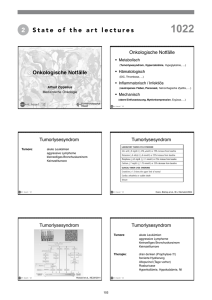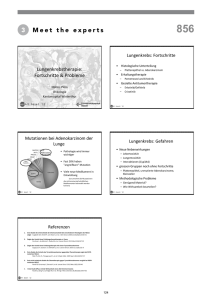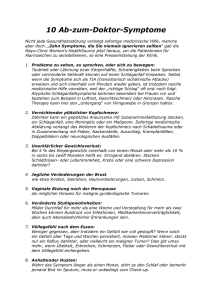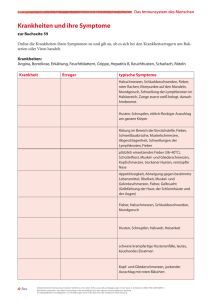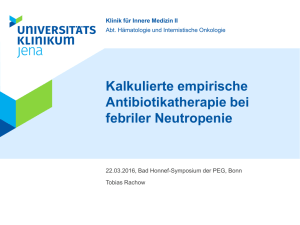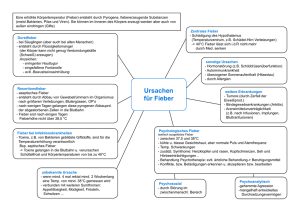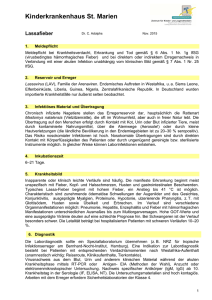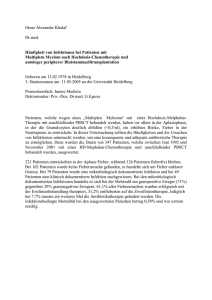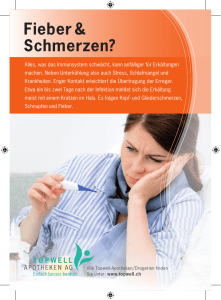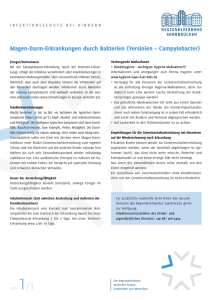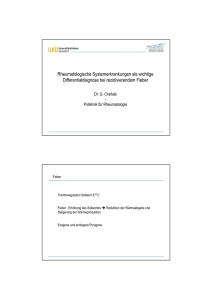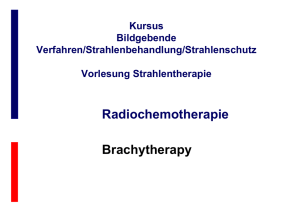Onkologische Notfälle
Werbung
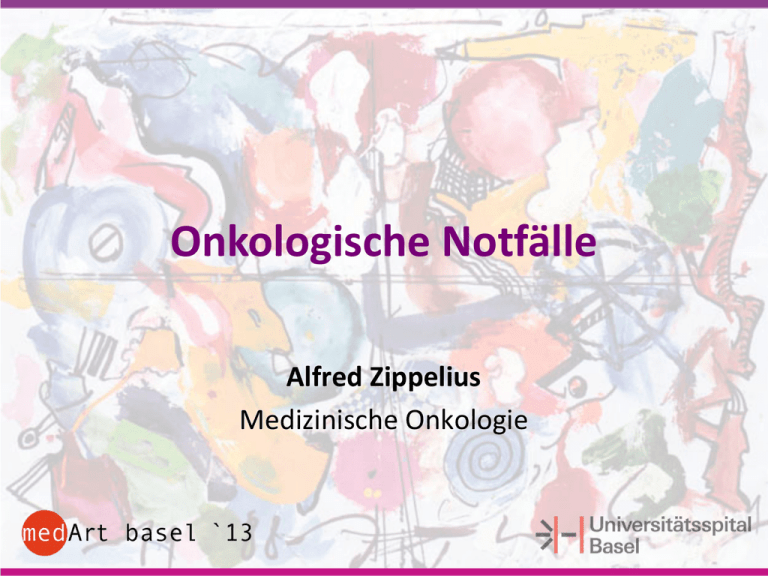
Onkologische Notfälle Alfred Zippelius Medizinische Onkologie • Onkologische Notfälle begegnen nicht nur Onkologen ! • komplexe Situation • Prävention bzw. frühe Detektion Onkologische Notfälle Metabolisch (Tumorlysesyndrom, Hypercalcämie, Hypoglykämie, …) Hämatologisch (DIC, Thrombose, ...) Inflammatorisch / Infektiös (neutropenes Fieber, Paravasat, hämorrhagische Zystitis, ... ) Mechanisch (obere Einflussstauung, Myelonkompression, Ergüsse, …) Tumorlysesyndrom Tumoren: akute Leukämie aggressive Lymphome kleinzelliges Bronchuskarzinom Keimzelltumore Coiffier et al., J Clin Oncol 2008 Tumorlysesyndrom – nicht nur nach Chemotherapie Saylor et al., J Clin Oncol 2007; Krishnan et al., J Clin Oncol 2008 Tumorlysesyndrom - Klassifizierung Cairo, Bishop et al., Br J Hematol 2004 Tumorlysesyndrom - Pathophysiologie Howard et al., NEJM 2011 Tumorlysesyndrom - Therapie Tumore: akute Leukämie aggressive Lymphome kleinzelliges Bronchuskarzinom Keimzelltumore Therapie: dran denken (Prophylaxe !!!) forcierte Hydrierung Allopurinol (Tage vorher) Rasburicase (Fasturtec®) Hyperkaliämie, Hypokalzämie, NI nicht: Alkalisierung Tumorbedingte Hyperkalzämie - Inzidenz - - klinische Symptomatik variabel - schlechte Prognose ! Santarpia et al, Horm Metab Res 2010 Tumorbedingte Hyperkalzämie - Mechanismus - 80 % <1% 20 % < 0.1 % Clines GA, Curr Opin Endocrinol Diab Obes 2011 Hyperkalzämie Dran denken !!! • (Re-) Hydrierung • Lasix ? • Bisphosphonate (Geduld !, bei PTHrP weniger Effekt) • Spezifische Tumor-Therapie • Steroide ? • (Calcitonin, Plicamycin, Galliumnitrat) Neutropenes Fieber • Inzidenz 10 – 20 % der Patienten mit soliden Tumoren • Fieber ≥ 38.5°C oder ≥ 38.0°C (mindestens 2x über eine Stunde) • Neutropenie < 500/ml bzw. < 1000/ml mit einem zu erwartenden Nadir von < 500/ml Dauer ! - > Anamnese: WAS, WANN !!! Nadir Neutropenes Fieber • Inzidenz 50% der Patienten mit soliden Tumoren • Fieber im Ohr ≥ 38.3°C oder 2 x ≥ 38.0°C innert 1 h • Neutropenie < 500/ml bzw. < 1000/ml mit einem zu erwartenden Nadir von < 500/ml Dauer ! - > Anamnese: WAS, WANN !!! (Nadir ≈ 7 -12 Tage nach der letzen Chemotherapie) • Diagnostik BB, CRP, Chemogramm, BK, Thorax-Rx, Urin-Bakt • Mortalität unbehandelt > 70% • Therapie innert Stunden: empirische Antibiotika Mortalität bei neutropenem Fieber 100 80 60 40 20 0 1950 1960 1970 1980 1990 2000 Differenz v.a. aufgrund empirischer Antibiotika-Therapie Neutropenes Fieber: Mortalität heute 115 US-Spitäler 1995 – 2000 41‘779 Pat. Kuderer N, Cancer 2006 ;106:2258 Neutropenie-Tiefe und Dauer Infektrate Granulozyten Bodey GP et al., Ann Intern Med 1966;61:328 Therapie des Neutropenen Fiebers Sofortiger Beginn einer Pseudomonaswirksamen Antibiotikatherapie Antibiotika Dosierung Cefepime* 3x2g Piperacilllin/Tazobactam* 3 x 4.5 g Meropenem 3x1g * ggf. Plus Amikacin 15 mg/kg iv für 3 Tage Gezielte Therapie (mit breitem Spektrum) z.B. - Ambulante Pneumonie: + Clarithromycin 2 x 500 mg iv/po. Diarrhoe: + Metronidazol 3 x 500 mg po Keimnachweis: entsprechend Antibiogramm Freifeld et al., Clin Infect Dis 2011 ESBL-E.coli Träger bei hämatologischen Erkrankungen in Neutropenie 217 neutropene Episoden -> rektale Abstriche bei Spitaleintritt und danach wöchentlich ESBL-EC 29% (14% bei Eintritt) Arnan et al., Eur J Clin Microbiol 2011 ESBL-E.coli Träger bei hämatologischen Erkrankungen in Neutropenie 217 neutropene Episoden -> rektale Abstriche bei Spitaleintritt und danach wöchentlich ESBL-EC 29% (14% bei Eintritt) Arnan et al., Eur J Clin Microbiol 2011 Immer Hospitalisation? MASCC Scoring Index Multinational Association for Supportive Care in Cancer Scoring Index Ausmass der aktuellen Erkrankung keine od. milde Symptome 5* moderate Symptome 3* keine Hypotonie 5 keine COPD 4 Solider Tu od. keine Pilzinfektion 4 ≈ 60 % “low risk” keine Dehydratation 3 ≈ 90% Fieberresolution, Fieberbeginn zu Hause 3 Alter < 60 Jahre 2 >1100 Patienten erfasst ohne Komplikationen Score ≥ 21 Punkte = „low risk“ Klastersky J., JCO 2000 Outpatient Oral Antibiotics for Febrile Neutropenic Cancer Patients • Prospektive Validierung des MASCC-Scores: – orale + ambulante Antibiotika-Therapie nach kurzer Hospitalisation – primärer Endpunkt: Fieberrückgang ohne ernsthafte Komplikationen • 611 konsekutive Pat mit neutropenem Fieber – davon 441 MASCC-Score ≥ 21 (= low risk) – davon 189 geeignet für orale Therapie (= 43%) • Therapie: Ciprofloxacin 3 x 500 mg plus Co-Amoxicillin 3 x 625 mg Klastersky J., JCO 2006;24:4129 Outpatient oral antibiotics for NF • 5% ernsthafte Komplikationen – früh entlassene (n = 79): • 0% ernsthafte Komplikationen • 4% Wiedereintritte (Stomatitis, Schüttelfrost, pers. Fieber) – spät entlassene (n = 99): • 9% ernsthafte Komplikationen (2% ) Hypotonie, Konfusion, Sepsis, ANV, Resp. Insuffizienz Klastersky J., JCO 2006 Ambulante Therapie für neutropenes Fieber: Ja, aber: • nur für ausgewählte low-risk Patienten (MASCC ≥ 21 Punkte) • Nach 24 Std. stationärer Beobachtung • klin. Kontrolle + BE min. alle 2 Tage, dazw. Telefon-Kontakt • genaue Instruktion bezüglich Verhalten bei Fieber oder Komplikationen mit sofortiger Re-Hospitalisation • Antibiotika: – Augmentin 3 x 625mg – Ciproxin 2 x 750mg G-CSF? Neutropenes Fieber: • Verkürzung der Neutropeniedauer sowie Hospitalisation • kein Einfluss auf Mortalität (early + infection – related) -> keine Empfehlung Primäre Prophylaxe: • Reduktion der Inzidenz, Länge und Schwere • Reduktion der Mortalität (early + infection – related) • Steigerung der Chemotherapie-Dosis -> Empfehlung: bei ≥ 20% Risiko (kurativ, ≥ 10% mit RF) Clark et al, J Clin Oncol 2005; Kuderer et al, J Clin Oncol 2007 Clinical Practive Guidelines of the Infectious Diseases Society of America 2010 Paravasate Inzidenz: Risikofaktoren: 0.01 – 6% Arzt, Patient, Substanz Paravasate Langer et al, Curr Oncol Rep 2010 Paravasate: Erste Massnahmen • Infusion STOP • Nadel belassen/nicht spülen • Arm hoch lagern • Aspiration aus Nadel/Subcutis • Kein Druck • Spezifische Massnahmen • Dokumentieren!!! Paravasate: Therapie * * * Dexrazoxane • ggf. Chirurgen beiziehen Wengström et al., Eur J Oncol Nurs 2008 Polovich et al., Oncology Nursing Society 2009 Obere Einflussstauung Obere Einflussstauung - Klinik - Wilson et al, NEJM 2007 Obere Einflussstauung - Tumor als Ursache - Wilson et al, NEJM 2007 Obere Einflussstauung - Therapie - • Diagnostik • Supportive Therapie (Steroide ?) • Chirurgie • Chemotherapie • Radiotherapie • Stent Wilson et al, NEJM 2007 Myelonkompression Inzidenz: Mechanismus: Lokalisation: 5% aller Tumorpatienten direkte Kompression, vasogenes Ödem 15% zervikal, 60% thorakal, 25% lumbosakral Cole et al., Lancet 2008 Myelonkompression Mamma, Prostate, Lunge 45 – 60 % NHL, Niere, Myelom 15 – 30 % Kolorektal, Sarkom, CUP 3 – 13 % In 10 – 20 % Erstdiagnose (red flags !) Cole et al., Lancet 2008 Symptome • Schmerz fast immer (bis 95%) zuerst – konstant, dumpf, ziehend, progredient – schlimmer in Rückenlage (Hernie umgekehrt !), Niesen, Bewegung, Nackenbeugen • Motorische Schwäche • Sensibilitätsverlust/Parästhesie • autonome Dysfunktion (Urin, Stuhl, Impotenz) Behandlung • Dexamethason >10 mg i.v., dann 4-8 mg alle 6 Std. wenn stabil, alle 4 Tage Dosisreduktion • Multidisziplinär: – Chemotherapie – Radiotherapie – Chirurgie Radiotherapie • wichtigste Therapieform • radiosensitive Tumoren ohne spinale Instabilität oder knöcherne Kompression des Myelons • Dosis und Fraktionierung unklar Chirurgie Chirurgische Dekompression: • rasche neurologische Progression • spinale Instabilität oder knöcherne Kompression des Myelon (Wirbel-Hinterwand) • kein Ansprechen auf Radiotherapie aber: individuelle Entscheidung für den einzelnen Patienten ! Randomisierter Vergleich 1° endpoint: ambulatory rate, i.e. ability to walk after tx Patchell et al., Lancet 2005 OP + Radiotherapie > Radiotherapie Ambulatory rate: 84 % vs. 57 % (p = 0.001) length of time patients remained ambulatory after tx Patchell et al., Lancet 2005 Spinale Instabilität (Scoring Index, Spine Oncology Study Group) Fisher et al., Spine 2010; Fourney et al., JCO 2011 Myelonkompression „Take Home Messages“ Wenn immer möglich, die drei Fachdisziplinen Chirurgie, Radiotherapie, Onkologie gleichzeitig am Patientenbett Geschwindigkeit entscheidend !!! (ca. 80% können später gehen, wenn noch keine Paralyse bei Therapiebeginn - sonst ca. 10%) Literatur zu Referat „Onkologische Notfälle“, A. Zippelius: 1. Howard SC, Jones DP, Pui C-H The tumor lysis syndrome. New England J. Medicine 2011; 364: 1844-1854 2. Clines GA Mechanisms and treatment of hyercalcemia of malignancy. Curr Opin Endocrinol Diabetes Obes 2011; 18: 339-346 3. Bennett CL, Djulbegovic B, Norris LB, Armitage JO. Colony-stimulating factors for febrile neutropenia during cancer therapy. N Engl J Med 2013; 368: 1131-1139. 4. Flowers CR, Seidenfeld J, Bow EJ, Karten C, Gleason C, Hawley DK, Kuderer NM, Langston AA, Marr KA, Rolston KV, Ramsey SD. Antimicrobial prophylaxis and outpatient management of fever and neutropenia in adults treated for malignancy: American Society of Clinical Oncology clinical practice guideline. J Clin Oncology 2013; 31: 794-810 5. Wilson LD, Detterbeck FC, Yahalom J. Superior Vena cava sysndrome with malignant causes. New England J Medicine 2007; 356:1862-1869 6. Cole JS, Patchell RA. Metastatic epidural spinal cord compression. Lancet Neurol 2008; 7:459-466 7. McCurdy MT, Shanholtz CB. Oncologic emergencies. Crit Care Med 2012; 40:2212-2222 8. Morgan C, Tillett T, Braybrooke J, Ajithkumar T. Management of uncommon chemotherapy-induced emergencies. Lancet Oncol 2011; 12:806-814
